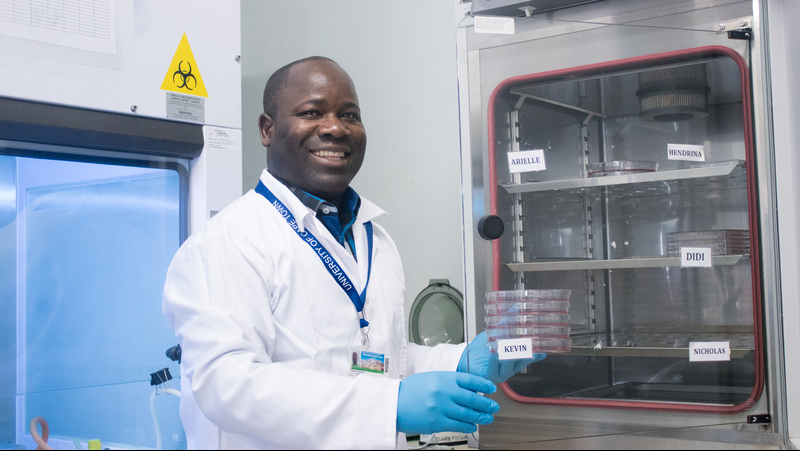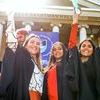Harnessing the healing power of stem cells
17 November 2017 | Story Ambre Nicolson. Photo Lerato Mokhethi.
Newly selected Next Einstein Fellow Kevin Dzobo is a man with a simple desire: he wants to bring the healing power of stem-cell therapies to ordinary patients. But, while his aim can be simply stated, the science required to make it a reality is complex.
Dzobo grew up in Mutare in Zimbabwe, the eldest boy of 10 siblings. “My family has a royal lineage and perhaps because of this when I was a child my parents impressed on me the importance of high standards and trying to help other people.”
Growing up in the 1990s he was also surrounded by the ravaging effects of HIV/AIDS, TB and malaria. “At that time whole families were being wiped out, parents leaving children, the heads of families becoming absent,” Dzobo remembers.
From then onwards he knew that one day he wanted to work in the medical field. But he couldn’t have guessed that his future lay in genetic engineering, cancer biology and cutting-edge stem-cell research. “No,” laughs Dzobo, “at the time my field didn’t even really exist, not in its present form anyway.”
‘Africa must keep up’
In many ways it is the very newness of his field of study that motivates him in his current work as senior research scientist at the International Centre for Genetic Engineering and Biotechnology (established as a special project by the United Nations Industrial Development Organisation) and Department of Integrative Biomedical Sciences at UCT.
“When it comes to stem-cell science, we in Africa cannot afford to be left behind,” he explains. Dzobo gives the example of cellular communications technology that was developed in other parts of the world long before Africa. “Africa had to play catch-up with that kind of technology and I don’t think we can afford to do that again,” he says, “not when stem-cell science has such vast potential for the treatment of all kinds of disease.”
The treatment of a range of human ailments around the world is bedevilled by a reliance on organ donations, which could be augmented by tissue engineering and regenerative medicine.
For Dzobo this means placing equal emphasis on sourcing research funding and encouraging knowledge transfer, so that research can continue at leading academic institutions on the continent. Dzobo was recently elected as the vice president of the African Tissue Engineering and Regenerative Medicine International Society (ATERMIS); he aims to advocate against the main drivers of technological disparities such as the lack of financial support and commitment by African governments for research and development – especially in the fields of tissue engineering and regenerative medicine. Currently, Dzobo is finalising international collaborations so as to bring standards, methods and research practices to meet internationally accepted levels.
“We are already seeing private enterprise investing in the field to a huge degree. This can lead to the fast-tracking of exciting new discoveries, but we also need to ensure that such knowledge remains in the public realm if it is to make a difference in ordinary people’s lives,” he says.
So how did he go from an enthusiastic high-school student to an internationally recognised, passionate advocate for and researcher in stem cell research in Africa?
From syrups to fibroblasts
Throughout his primary school years, Dzobo was second to another student only once. Dzobo graduated from the University of Zimbabwe with a distinction for a bachelor of science and an honours degree in biochemistry. He was awarded a university book prize for his endeavours and was the top student in his year. “Due to lack of funding for postgraduate studies in Zimbabwe,” he says, “I could not immediately continue my studies and instead I spent the next four years working in a pathology lab as a biochemist, doing all sorts of tests from HIV to malaria. I then started working as a shift manager making syrups in a production facility.”
In 2004 he moved to Cape Town with his girlfriend (now his wife) to begin his master’s studies at UCT. South Africa was supposed to be a detour, en route to the United Kingdom. Less than two years later – and still at UCT – he had completed his MSc in molecular and cell biology and started his PhD.
The focus of his doctoral studies was the growth and repair of tissue – in particular, a special kind of cell called a fibroblast. “A fibroblast creates the extracellular matrix (ECM), which is like a scaffolding structure of tissue),” explains Dzobo, “This structure plays an important role in the tumour microenvironment and has an effect on metastasis, tumour growth and carcinogenesis.”
In 2011, while a postdoctoral research fellow at UCT, Dzobo was awarded the Arturo Falaschi International Centre for Genetic Engineering and Biotechnology (ICGEB) International Postdoctoral Fellowship, which led to an appointment as senior research scientist at ICGEB and later as a lecturer at UCT’s Department of Integrative Biomedical Science.
To his many national and international achievements can be added Dzobo’s selection this year as a Next Einstein Forum (NEF) Fellow in recognition of his strong scientific record and potential for outstanding leadership. His Einstein challenge is to bring stem cell-based treatments to patients – he hopes to develop easier and cheaper methods or technologies to stimulate stem cells into tissue-forming cells that can be used to treat several diseases and pathological conditions.
Cancer stem cells
When most people hear the term “stem-cell therapy” they think of treating cancer using stem cells. These days Dzobo is focusing on the cancer stem cells themselves. Or as he puts it: “Most people think of a cancerous tumour as being a homogenous mass of malignant cells, but in fact a tumour is made up of several – sometimes hundreds – of different kind of cells. This phenomenon, termed ‘tumour heterogeneity’, has confounded doctors and scientists.”
In treating many different kinds of cancer, doctors often use chemotherapy to target tumours. The problem, he explains, is that these drugs are often only effective against one or several of the malignant cells that are present in a tumour.
“Too often what then happens is that the therapy is either ineffective, or worse – that it in fact allows certain of the malignant cells to grow faster,” he says. He now hopes to discover more about the cancer stem cells present in a tumour so that, in his words, “we can take the root out, not just chop off the leaves”.
Dzobo is also leading an inter-university collaboration project between UCT, the ICGEB and the University of Pretoria, looking into ways of creating a stem-cell ECM bandage, which would help to regenerate injured tissue.
“In the future, I hope to play a part in unlocking the vast potential of stem-cell therapies in increasing longevity, the treatment of degenerative conditions and chronic disease,” says Dzobo. “I would like to see ordinary people in the street start to benefit from these scientific breakthroughs, and I believe that it is possible in the near future.”
 This work is licensed under a Creative Commons Attribution-NoDerivatives 4.0 International License.
This work is licensed under a Creative Commons Attribution-NoDerivatives 4.0 International License.
Please view the republishing articles page for more information.
Research & innovation





































